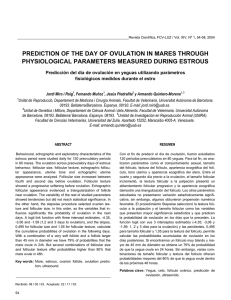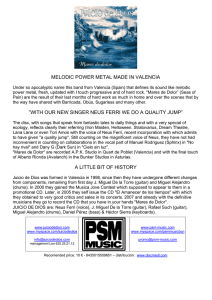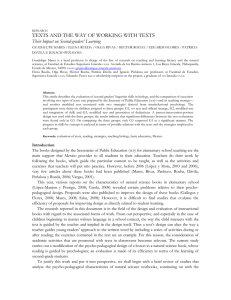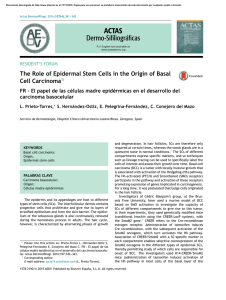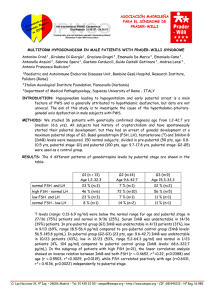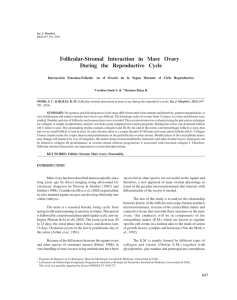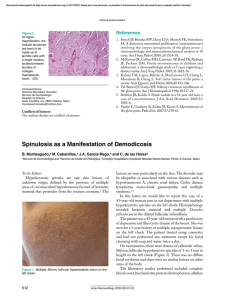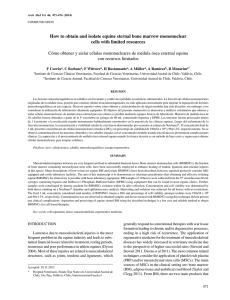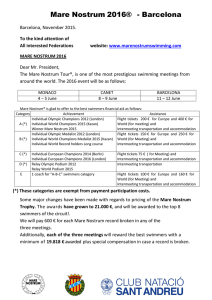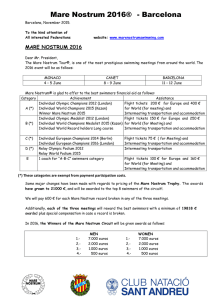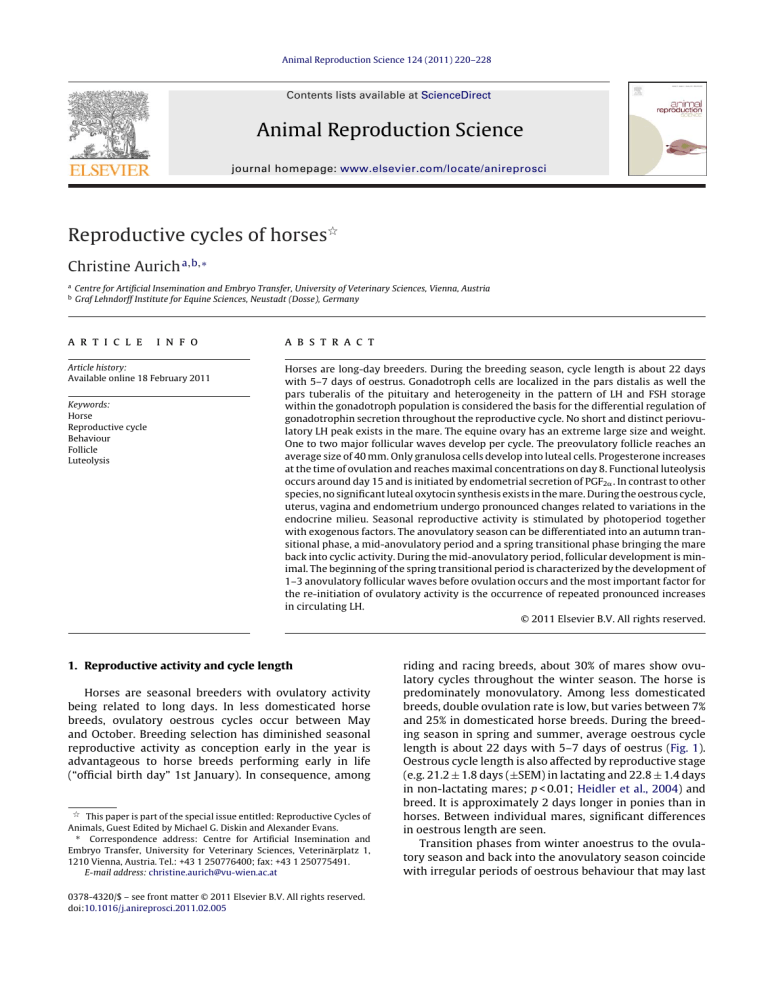
Animal Reproduction Science 124 (2011) 220–228 Contents lists available at ScienceDirect Animal Reproduction Science journal homepage: www.elsevier.com/locate/anireprosci Reproductive cycles of horses夽 Christine Aurich a,b,∗ a b Centre for Artificial Insemination and Embryo Transfer, University of Veterinary Sciences, Vienna, Austria Graf Lehndorff Institute for Equine Sciences, Neustadt (Dosse), Germany a r t i c l e i n f o Article history: Available online 18 February 2011 Keywords: Horse Reproductive cycle Behaviour Follicle Luteolysis a b s t r a c t Horses are long-day breeders. During the breeding season, cycle length is about 22 days with 5–7 days of oestrus. Gonadotroph cells are localized in the pars distalis as well the pars tuberalis of the pituitary and heterogeneity in the pattern of LH and FSH storage within the gonadotroph population is considered the basis for the differential regulation of gonadotrophin secretion throughout the reproductive cycle. No short and distinct periovulatory LH peak exists in the mare. The equine ovary has an extreme large size and weight. One to two major follicular waves develop per cycle. The preovulatory follicle reaches an average size of 40 mm. Only granulosa cells develop into luteal cells. Progesterone increases at the time of ovulation and reaches maximal concentrations on day 8. Functional luteolysis occurs around day 15 and is initiated by endometrial secretion of PGF2␣ . In contrast to other species, no significant luteal oxytocin synthesis exists in the mare. During the oestrous cycle, uterus, vagina and endometrium undergo pronounced changes related to variations in the endocrine milieu. Seasonal reproductive activity is stimulated by photoperiod together with exogenous factors. The anovulatory season can be differentiated into an autumn transitional phase, a mid-anovulatory period and a spring transitional phase bringing the mare back into cyclic activity. During the mid-anovulatory period, follicular development is minimal. The beginning of the spring transitional period is characterized by the development of 1–3 anovulatory follicular waves before ovulation occurs and the most important factor for the re-initiation of ovulatory activity is the occurrence of repeated pronounced increases in circulating LH. © 2011 Elsevier B.V. All rights reserved. 1. Reproductive activity and cycle length Horses are seasonal breeders with ovulatory activity being related to long days. In less domesticated horse breeds, ovulatory oestrous cycles occur between May and October. Breeding selection has diminished seasonal reproductive activity as conception early in the year is advantageous to horse breeds performing early in life (“official birth day” 1st January). In consequence, among 夽 This paper is part of the special issue entitled: Reproductive Cycles of Animals, Guest Edited by Michael G. Diskin and Alexander Evans. ∗ Correspondence address: Centre for Artificial Insemination and Embryo Transfer, University for Veterinary Sciences, Veterinärplatz 1, 1210 Vienna, Austria. Tel.: +43 1 250776400; fax: +43 1 250775491. E-mail address: [email protected] 0378-4320/$ – see front matter © 2011 Elsevier B.V. All rights reserved. doi:10.1016/j.anireprosci.2011.02.005 riding and racing breeds, about 30% of mares show ovulatory cycles throughout the winter season. The horse is predominately monovulatory. Among less domesticated breeds, double ovulation rate is low, but varies between 7% and 25% in domesticated horse breeds. During the breeding season in spring and summer, average oestrous cycle length is about 22 days with 5–7 days of oestrus (Fig. 1). Oestrous cycle length is also affected by reproductive stage (e.g. 21.2 ± 1.8 days (±SEM) in lactating and 22.8 ± 1.4 days in non-lactating mares; p < 0.01; Heidler et al., 2004) and breed. It is approximately 2 days longer in ponies than in horses. Between individual mares, significant differences in oestrous length are seen. Transition phases from winter anoestrus to the ovulatory season and back into the anovulatory season coincide with irregular periods of oestrous behaviour that may last C. Aurich / Animal Reproduction Science 124 (2011) 220–228 Fig. 1. (a) Concentrations of FSH and oestradiol in the peripheral circulation and size of the largest follicle and (b) concentrations of LH, progesterone and prostaglandin F2alpha in the peripheral circulation throughout the equine oestrous cycle. from several days to weeks and thus vary considerably in length. In fillies, puberty occurs approximately at an age of 12–18 months. This age is again influenced by season. In fillies born very early in the year puberty will not occur before the beginning of the breeding season of the following year. Senescence in old mares is rarely seen and most mares continue to cycle independent of age. However, in old mares, the interovulatory interval may be longer than in young and middle-aged mares due to a slower growth rate of the dominant follicle (Ginther et al., 2008). 2. Reproductive behaviour Oestrous behaviour of the mare is characterized by increased interest in stallions and proceptive behaviour in response to the sexual attractivity of a stallion (CrowellDavis, 2007). The oestrous mare will turn her hindquarters to the stallion and show a characteristic posture with lowered pelvis and straddled hind limbs. This is accompanied by deviation of the tail and exposition of the perineal region together with “clitoral winking” (rhythmic eversion of the clitoris) and frequently voidance of small quantities of urine. Frequent urination ensures contact to the stallion who will show an olfactory response including frequent flehmen. The behaviour of the mare thus may function in chemosensory priming of the stallion for reproduction (Crowell-Davis, 2007). In oestrous mares, a unique facial expression occurs that is characterized by relaxed facial muscles, ears turned to side and a lowered head. In contrast to oestrous mares, luteal phase mares will be less interested in a stallion. If a stallion approaches, they will start to squeal, strike and kick at the stallion. Their face will express a kind of aggressiveness characterized by tension of the 221 facial muscles, ears turned back and often threatening to bite at the stallion (Crowell-Davis, 2007). Under feral conditions, horses live in stable family groups that typically consist of adult mares, their young offspring and one adult harem stallion. Therefore, strong social bonds between mares and the stallion exist. Under today’s domesticated breeding conditions, the situation is completely different. Frequently, a mare will be exposed to a stallion to test her reproductive behaviour (“teasing”). However, in most cases, this stallion is not familiar to the mare and no social bond is formed. In addition, many mares show individual preferences for particular stallions and may avoid other stallions completely. These factors contribute to the situation that an oestrous mare does not always exhibit characteristic oestrous behaviour when exposed to a stallion. Equine oestrous behaviour is inhibited by progesterone and facilitated by oestradiol. However, even in anovulatory mares with small and inactive ovaries as well as in ovariectomized mares, oestrous behaviour is seen at irregular intervals. The behaviour ranges from mild interest in a stallion to the complete repertoire of oestrous behaviour including the acceptance of mounting and copulation (Hedberg et al., 2007). Oestrous behaviour in nonovulatory mares is most likely caused by small amounts of oestradiol synthesized by the adrenal cortex together with a high sensitivity of the mare to steroid hormones (Crowell-Davis, 2007). In contrast to other species, in horses even the first oestrus in life as well as the first oestrus after the anovulatory winter season or after foaling is accompanied by characteristic oestrous behaviour. In the post partum mare, this facilitates early conception in foal heat and allows the production of a foal every year in spring which is the most appropriate time of the year under feral conditions. 3. Endocrine regulation of the oestrous cycle 3.1. Hypothalamic function In the horse, pituitary venous blood can be experimentally collected by a direct catherization technique. This allows determination of GnRH and gonadotrophin release directly from hypothalamic and pituitary outflow (Irvine and Alexander, 1987). In the mare, the gonadotrophins LH and FSH are considered to be under the control of GnRH alone. So far there is no evidence that a specific FSH-releasing factor exists in the horse. In the mare, most hypothalamic GnRH pulses are followed by LH pulses from the pituitary and more than 80% of LH pulses are accompanied by a pulse of FSH (Alexander and Irvine, 1987). The GnRH pulse frequency changes with the stage of the oestrous cycle and is low during the luteal phase with a GnRH pulse interval of approximately 120 min. On the day of ovulation, the GnRH pulse interval lasts approximately 30 min. This is similar to the GnRH pulse interval observed during the LH surge induced in ovariectomized ewes by oestradiol treatment (Alexander and Irvine, 1987). Hypothalamic GnRH release is modulated by steroid feedback mechanisms. However, the existence of steroid receptors on GnRH neurons has not been proven in the horse so far. Therefore, feedback mechanisms have to 222 C. Aurich / Animal Reproduction Science 124 (2011) 220–228 Table 1 Follicular development during the oestrous cycle of the mare: size of the largest follicle, concentrations of hormones in the peripheral circulation and occurrence within the largest follicle. Day of cycle Stage of the cycle Hormone concentration in the peripheral circulation Occurrence within the (later) dominant follicle 7 Development of the follicular wave • FSH ↑ • Emergence • Growth (all follicles of the wave) 13 17 Follicle deviation Beginning of the preovulatory phase • FSH ↓ • Continued growth (3 mm per day) • Oestradiol-17 ↑ • Inhibin ↑ • Activation of deviation mechanisms: • Sensitivity to FSH ↑ • Free IGF-I ↑ • Inhibin ↑ • Oestradiol ↑ • LH ↑ • Continued growth (3 mm per day) • Oestradiol-17 ↑ 19 21 Preovulatory phase Ovulation • LH → • Stagnation of growth • Oestradiol-17 ↑ • Maturation (characteristic pattern in the expression of different factors, e.g. PGE ↑, PGF2␣ ↑, prostaglandin dehydrogenase ↑) • LH ↑ • Granulosa cells → luteinization • Progesterone ↑ • Progesterone ↑ • Vascularization ↑ be mediated by higher brain areas. In the horse, endogenous opioidergic systems are activated by progesterone together with oestradiol. During the luteal phase, opioidergic systems inhibit hypothalamic GnRH and subsequent pituitary LH release while during the follicular phase, they are inactive and allow an increase in LH secretion (Aurich et al., 1995). 3.2. Pituitary function and gonadotrophin release Gonadotroph cells are localized in the pars distalis as well the pars tuberalis of the equine pituitary. Subsets of gonadotrophs that store and produce either LH or FSH (monohormonal gonadotrophs) and bihor- monal gonadotrophs that store both gonadotrophins exist together. Whereas in the pars distalis all three types of gonadotrophs have been identified, few if any FSH monohormonal cells exist in the pars tuberalis of the equine pituitary. This heterogeneity in the pattern of LH and FSH storage within the gonadotroph population is considered the morphological basis for the differential regulation of LH and FSH secretion throughout the equine reproductive cycle (Tortonese et al., 2001). The divergent pattern of LH and FSH release is more pronounced in the mare than in many other domesticated animal species (Fig. 1a and b). An early periovulatory rise in peripheral concentrations of LH is accompanied by a modest increase in FSH subsequently declining to its nadir C. Aurich / Animal Reproduction Science 124 (2011) 220–228 concentration (Bergfelt et al., 1991) while LH is reaching its maximum. In the mid-luteal phase, a second and robust FSH rise occurs with no concomitant increase in LH. This second FSH surge occurs on different days of the cycle among individual mares (Ginther et al., 2005). In contrast to other domestic animal species which exhibit a short and pronounced preovulatory LH surge, no distinct periovulatory LH peak exists in the mare. However, during oestrus the period of elevated concentrations of LH lasts for several days. The gradual increase in LH is transiently disrupted after ovulation due to absorption of oestradiol from follicular fluid that is suggested to be discharged into the abdomen at ovulation (Ginther et al., 2010). Peak concentration of immunological LH activity is reached not earlier than one day after ovulation, but is preceded by biological LH activity. Maximal LH bioactivity occurs shortly before ovulation (Alexander and Irvine, 1982). In pituitary blood, gonadotrophin pulse frequency rises from 0.5 pulses per hour early in the LH surge to 1.9 pulses per hour at the time of ovulation. In jugular blood, gonadotrophin pulses are relatively small and therefore difficult to detect. This is most likely the result of the long plasma half-life of both equine gonadotrophins (approximately 5 h). During the periovulatory period, the mean frequency of detectable gonadotrophin pulses in peripheral circulation increases to approximately 1 pulse per hour (Alexander and Irvine, 1987), while during the luteal phase the LH pulse frequency is as low as 0.1 pulses per hour (Alexander and Irvine, 1986). 3.3. Follicular development, follicular hormone production and ovulation Compared to other domestic animal species, the ovary of the mare has a unique structure characterized by an extremely large size and weight (35–120 cm3 in volume; 40–80 g in weight; Kimura et al., 2005), the presence of an ovulation fossa and an inverted location of its cortex and medulla. One to two distinct follicular waves develop during an oestrous cycle. A first major follicular wave can occur early in the luteal phase. The dominant follicle of this early wave may be anovulatory, but despite increased concentrations of progesterone ovulation can occur. The development of an ovulatory follicular wave during the luteal phase is a phenomenon considered unique to the equine species. However, it does not occur in all breeds of horses to the same extent: ponies usually develop one major follicle wave, while two follicular waves is typical of thoroughbreds and closely related sport horse breeds (e.g. warmbloods; Ginther, 2000). The emergence of each follicular wave is temporally associated with an FSH surge (Fig. 1a; Table 1). FSH reaches a plateau when the largest follicle reaches a size about 13 mm in diameter (Gastal et al., 1997). Subsequently, FSH declines to a concentration that does not support pronounced further growth of subordinate follicles but is sufficient for continuing growth of the dominant follicle. This size dissociation of the members of a follicular wave is known as follicle deviation or selection. Emergence of the future dominant follicle occurs at a size of 6 mm in diameter, approximately 6 days before follicle diameter deviation. At the time of deviation the largest and 223 second-largest follicle has an average size of 22 and 19 mm, respectively (Ginther, 2000). This phase of the dominant follicle is considered the decisive developmental stage. It coincides with rapid activation of deviation mechanisms that block further development of the second largest follicle to a similar decisive size. The inhibition of growth of the smaller follicles does not depend on follicle-to-follicle inhibitory mechanisms, but follicle deviation involves important changes in the largest follicle. These are characterized by an increased sensitivity to circulating concentrations of FSH. Dramatic changes in the insulin-like growth factor (IGF) system (IGF-I and -II, IGF binding protein, IGF binding protein proteases) in the largest follicle before the beginning of size deviation play a crucial role (Beg and Ginther, 2006). Simultaneously, the dominant follicle suppresses circulating concentrations of FSH, most probably due to follicular synthesis and release of oestrogens and inhibin. This hypothesis is supported by the finding of an increased oestradiol production in the future dominant follicle one day before follicle deviation (Gastal et al., 1999) together with an inverse relationship between circulating concentrations of FSH and inhibin in the cyclic mare (Bergfelt et al., 1991). It is feasible that systemic LH is not involved in follicle deviation but is required for further growth of the dominant follicle after the beginning of deviation (Ginther, 2000). With regard to preovulatory follicular development and ovulation horses differ from other farm animal species. The preovulatory follicle is much bigger and ruptures at a specific region of the ovary – the ovulation fossa. From deviation onwards, the preovulatory follicle grows at an average rate of 3 mm per day to a diameter of approximately 35 mm four days before ovulation. Continued growth occurs up to 2 days before ovulation when follicular size reaches a plateau of approximately 40 mm (Fig. 3a; Ginther et al., 2008). However, equine follicles may grow up to a preovulatory size of 55 mm and more, with mares ovulating consistently from similar preovulatory diameters in consecutive cycles (Cuervo-Arango and Newcombe, 2008). Histological maturation of the equine preovulatory follicle is characterized by an extensive expansion of its entire mural granulosa cell layer. Furthermore, accumulation of extracellular matrix is abundant. The ovulatory process of the equine follicle involves a specific and unique pattern of gene regulation in theca and mural granulosa cells. This includes differences in the expression of a variety of factors among them prostaglandins and prostaglandin metabolizing enzymes (Sayasith et al., 2007). During ovulation, oocyte and corona radiata enter the oviduct, while most of the follicular fluid passes into the peritoneal cavity. Hormones from this fluid are rapidly absorbed into the circulation leading to a pronounced increase in concentrations of inhibin on the day of ovulation (Bergfelt et al., 1991). Double ovulations may occur in horses. The double ovulation rate is affected by various factors such as breed, reproductive status and age and pharmacological manipulation of the oestrous cycle. The incidence of spontaneous double ovulation varies between approximately 2% in ponies and 25% in thoroughbreds, respectively. When two dominant follicles (two follicles >28 mm) develop in the 224 C. Aurich / Animal Reproduction Science 124 (2011) 220–228 same follicular wave, double ovulations occur in about 40% of mares (Ginther et al., 2008). These may occur synchronously (within 12 h), but intervals up to two days and more have been reported between ovulations and can lead to the establishment of a twin pregnancy. During the 2.5 immediately days before ovulation, the rate of dominant follicle growth in double ovulating mares is less pronounced than in single ovulating mares resulting in a lower preovulatory follicle diameter in twin ovulating mares. The reduced follicular growth is related to lower FSH concentrations, most probably due to higher oestradiol concentrations from the two preovulatory follicles (Ginther et al., 2008). 3.4. Luteal function Due to the specific anatomy of the ovary, the corpus luteum (CL) of the mare enlarges within the internal part of the ovary and does not protrude to the outer ovarian surface as in other species. The equine CL has a pearlike shape and comprises many small compartments with rough surface textures (Kimura et al., 2005). Structures of the equine CL are formed by luteal and non-luteal cells. As in other species luteal cells can be distinguished into large and small luteal cells. However, in contrast to many other species, luteal cells of the mare are not of thecal origin, but derive exclusively from the granulosa cells of the preovulatory follicle (Van Niekerk et al., 1975). At ovulation, thecal cells are at various stages of degeneration and are subsequently replaced by hypertrophied fibroblasts (Van Niekerk et al., 1975). Non-luteal cells of the corpus luteum are mainly fibroblasts, smooth muscle cells, macrophages and endothelial cells that originate from vascular endothelium of the postovulatory follicle. In the early luteal phase, progesterone producing luteal cells show pronounced mitotic activity (Aguilar et al., 2006). Luteal development is further characterized by intense angiogenesis regulated by angiogenic factors such as vascular endothelial growth factor (VEGF) produced by luteal cells (Al-zi’abi et al., 2003). In the mare, circulating concentrations of progesterone immediately increase at the time of ovulation (Roberto da Costa et al., 2005). Maximal concentrations of progesterone are reached on day 8 after ovulation and then slowly decrease until the onset of luteolysis that begins at approximately day 14 (Fig. 1b). Transrectal ultrasound has elucidated a parallel and progressive decrease in the mean cross-sectional area of the CL from day 4 to day 19 of the cycle (Ginther et al., 2007). However, the volume of hormone producing luteal cells significantly increases from early to mid-luteal phase when a maximal volume is reached (Van Niekerk et al., 1975; Aguilar et al., 2006). As in other species, in the mare, CL function is under control of LH and progesterone. However, expression of progesterone receptors can only be detected in large luteal cells but not in small luteal cells. This finding together with an inconsistent or failure to detect steroidogenic enzymes in small luteal cells has led to the suggestions that, in the mare, synthesis of progesterone is restricted to large luteal cells (Roberto da Costa et al., 2005; Ferreira-Dias et al., 2007). This is in contrast to many other species where both luteal cell types are involved in progesterone production. The hypothesis is supported that equine small luteal cells are just precursors of large luteal cells that advance in size and function during the development of the CL (Van Niekerk et al., 1975; Roberto da Costa et al., 2005). 3.5. Luteolysis Functional luteolysis in the mare is characterized by a pronounced decrease in blood concentrations of progesterone at around days 15–17 of the cycle. Morphologic regression of the CL develops later and more slowly (Ginther et al., 2005, 2007). Functional luteolysis coincides with a pronounced decrease in expression of P450scc (Watson et al., 2005). Simultaneously, the majority of hormone-producing luteal cells undergo cell death characterized by an increase in apoptotic markers. However, during that time a subset of luteal cells still enters the early stages of cell division. Expression of vascular endothelial growth factor (VEGF) declines at early regression of the CL but does not precede apoptosis in luteal cells. Therefore, in the mare functional luteolysis is not initiated by endothelial cell death within the CL (Aguilar et al., 2006) and no acute changes in blood flow contribute to luteolysis (Ginther et al., 2007). A regulatory role of the IGF system not only in follicular but also in luteal function in the mare has been suggested. Most probably, an increase in IGFBP2 at the time of luteolysis decreases the bioavailability of IGFs in the CL. Thus, functional luteolysis is facilitated by inhibiting the protective effect of IGFs on apoptosis and their stimulatory effect on steroidogenesis (Watson et al., 2005). In the mare, the initial signal for luteolysis is endometrial secretion of PGF2␣ during the late luteal phase. In contrast to ruminants, PGF2␣ is secreted into the peripheral circulation and no local counter current system (i.e. between uterine veins and ovarian arteries) exists in the horse. However, the equine corpus luteum is believed to have a much higher binding affinity for PGF2␣ resulting in a greater sensitivity to this hormone. At day 15 of the cycle, COX-2 expression in uterine epithelial cells of nonpregnant mares is markedly increased. No parallel changes in expression of other enzymes involved in prostaglandin synthesis were found, but COX-2 expression is inhibited in the endometrium of pregnant animals. The regulation of endometrial expression of COX-2 is therefore considered a key event in either induction of luteolysis or maternal recognition of pregnancy in the mare (Boerboom et al., 2004). As in other species, the release of equine endometrial PGF2␣ is stimulated by oxytocin. During late dioestrus, initial oxytocin secretion is most probably originating from the hypophysis. In contrast to other species, no significant luteal oxytocin synthesis exists in the mare, but the horse is the only domestic species were oxytocin has been localized in the endometrium. Specific secretory endometrial cells containing oxytocin have been described (Bae and Watson, 2003). Therefore, a paracrine–autocrine system involving endometrial oxytocin and PGF2␣ release is accelerating luteolysis in the non-pregnant mare (Fig. 2). C. Aurich / Animal Reproduction Science 124 (2011) 220–228 225 Fig. 2. Suggested endocrine regulation of luteolysis in the mare. 4. Oestrous cycle-induced changes of uterus, vagina and endometrium During the oestrous cycle, the uterus, vagina and endometrium of the mare undergo pronounced changes related to variations in the endocrine milieu. They can easily be differentiated by clinical examination. During oestrus, high concentrations of oestrogen and low concentrations of progesterone contribute to increasing uterine wall oedema together with opening of the cervix and flattening of uterus and vagina. Histologically, the endometrial oedema is most apparent in the stratum compactum. It is often associated with accumulation of varying small amounts of fluid within the uterine lumen (Tunón et al., 1995). Using transrectal ultrasonography the oestrous oedema of the endometrium is easily detectable as it results in the appearance of individual endometrial folds (Fig. 3b). These show areas of different echotexture: nonechogenic areas are corresponding with the oedematous portions of the folds while echogenic areas are corresponding with their tissue-dense central portions. Altogether the endometrial oedema results in a characteristic ultrasonographic picture of the uterus of the oestrous mare. In contrast, during the luteal phase the uterine wall has a mild contractility and the cervix is firmly closed. The uterine echotexture is homogenous and no oedema should be present. In the mare, patterns of secretory and ciliary activity of the endometrium are similar to other species. During oestrus, cells of the polygonal microvillous type dominate the cell population. Secretory cells located around the openings of endometrial glands are of the apocrine (Samuel et al., 1979) or merocrine type (Tunón et al., 1995). During oestrus, secretory activity of the endometrium together with increased myometrial activity contributes to uterine clearance mechanisms that void uterine infection. Equine endometrial secretory cells produce, store and secrete oxytocin and are thus most likely involved in stimulating and maintaining uterine contractility (Bae and Watson, 2003). Uterine clearance after breeding is further supported by invasive cells, mainly granulocytes and intraepithelial macrophages located particularly in the luminal epithelium of the uterine body (Tunón et al., 1995). After oestrus, the number of secretory endometrial cells rapidly declines and only few are present during the luteal phase. In parallel, the number of ciliated cells increases and reaches a maximum at mid dioestrus but again declines towards the end of the luteal phase (Samuel et al., 1979). Fig. 3. Transrectal ultrasonography of (a) a preovulatory follicle and (b) uterine oedema in an oestrous mare. 226 C. Aurich / Animal Reproduction Science 124 (2011) 220–228 Endometrial changes related to the oestrous cycle are regulated by the ovarian steroid hormones progesterone and oestrogens interacting with their endometrial receptors. Progesterone and oestrogen receptors exist in the luminal epithelium, glandular epithelium and stroma of the equine endometrium. Their expression is markedly influenced by the stage of the oestrous cycle. It is maximal during oestrus and minimal during late dioestrus suggesting that steroid hormone receptor expression in the equine endometrium is stimulated by oestrogens and down-regulated by progesterone. This is in agreement with the situation in ruminants (Hartt et al., 2005). 5. Regulation of seasonal reproductive activity In the horse, seasonal reproductive activity is stimulated by long days and short nights (Palmer and Guillaume, 1992). In addition to photoperiod, exogenous factors such as age, reproductive state, nutrition, body condition and environmental temperature affect seasonal reproductive activity of the mare tremendously. Therefore, in most horse populations a proportion of mares continue to cycle throughout the year (see Section 1). During the winter anovulatory season which lasts approximately from October to March, prolonged phases of melatonin secretion contribute to reduce hypothalamic GnRH content and release. However, annual reproductive rhythms also occur in pinealectomized horses, but are no longer strictly synchronous with the geophysical year (Grubaugh et al., 1982). This indicates that seasonal changes in reproductive activity in the horse are driven by an endogenous rhythm that is synchronized to the geophysical year by photoperiod. While mean plasma concentrations of FSH and pituitary content of FSH are relatively constant throughout the year, mean plasma concentrations of LH reach a maximum in summer and are lowest in anovulatory mares. In the peripheral circulation, LH pulses are almost undetectable during winter anoestrus (Alexander and Irvine, 1986). Pronounced seasonal effects on the incidence of gonadotrophs in the pars tuberalis of the equine pituitary exist. In cyclic animals during the breeding season as well as in sexually active mares during the non-breeding season, the density of gonadotrophs in the pars tuberalis is four to five times higher than in seasonally anovulatory mares. In contrast, no effects of season or reproductive activity on the density of the gonadotrophs in the pars distalis of the pituitary occur. The seasonal pattern in the density of gonadotrophs of the pars distalis is most probably the main mechanism underlying the differential release of LH and FSH throughout the annual reproductive cycle of the mare (Tortonese et al., 2001). In the mare, the anovulatory season can be differentiated into an autumn transitional phase from cyclic activity to deep anoestrus, a mid-anovulatory period and a second transitional phase to cyclic activity in spring. During the autumn transitional phase, inadequate gonadotrophin stimulation in early dioestrus seems to be a critical event leading to suboptimal follicular development and subsequent acyclicity. In the last ovulatory cycle of the season, the periovulatory nadir in concentrations of FSH is pro- longed and the early dioestrus FSH surge is reduced when compared to ovulatory cycles during the breeding season. Simultaneously, LH secretion is impaired with a shortened LH surge. Subsequently, the LH surge fails to occur at the expected time of the cycle and results in anovulation (Irvine et al., 2000). Failure of ovulation is followed by a phase of variable levels of follicular activity before follicular growth is reduced to deep anoestrous levels. During this period, follicular growth is minimal, only a few follicles have a diameter of more than 15 mm and the maximal diameter of the largest follicle does not exceed 16 mm. A dominant follicle does not develop during that time. Low circulating concentrations of LH contribute to this reduction in follicular growth. However, FSH surges and follicular waves can be distinguished throughout the anovulatory season (Donadeu and Watson, 2007). The spring transitional period has a variable length that ranges from 30 to 90 days. Its beginning is characterized by the re-initiation of follicular deviation, i.e. the development of a dominant follicle reaching a size between 20 mm and 30 mm in diameter. In addition, an increasing number of follicles with a diameter greater than 15 mm occur. Subsequently, 1–3 anovulatory follicular waves develop before ovulation occurs (Donadeu and Watson, 2007). The switch in follicular development between the deep anovulatory phase and spring transition is not attributable to differences in pituitary FSH release. As in sheep, a low expression of follicular FSH receptors during deep anoestrus and a much higher expression in ovulatory mares explain a different sensitivity of follicles to FSH. Most likely, changes at the ovarian level contribute to these differences, among them changes in the expression of dopamine D2 receptors in the ovarian cortex (King et al., 2008) or in the expression of members of the IGF system within ovarian follicles. Seasonal changes in the concentrations of circulating hormones such as prolactin or growth hormone are most likely involved (Donadeu and Watson, 2007). The most important factor for the re-initiation of ovulatory activity at the end of the transitional phase is the occurrence of surges in circulating LH. As during the ovulatory season (Ginther, 2000), systemic LH is required for further growth of the largest follicle after the beginning of deviation. In contrast to ovulatory follicles, the dominant follicles of the anovulatory follicular waves during spring transition in the presence of lower circulating LH concentrations still show a poorly developed theca layer, scant vascularisation and a deficiency in steroidogenesis early in the steroidogenic pathway (Donadeu and Watson, 2007). Resumption of steroidogenesis increases gradually in successive anovulatory follicles during spring transition. A further increase in LH release seems to be the key event that finally leads to the first ovulation. 6. Manipulation of reproductive activity in the mare Reasons for the manipulation of reproductive activity in the mare are numerous. They range from induction of ovulatory cycles in seasonal anovulatory mares to produce early offspring over timing of ovulation in mares bred with semen of limited availability to suppression of oestrous behaviour in performance mares. However, the availabil- C. Aurich / Animal Reproduction Science 124 (2011) 220–228 ity of the drugs used may change and often differs between countries. Moreover, it has to be considered that in brood mares, pharmacological manipulation of the oestrous cycle increases the incidence of twin pregnancies (e.g. 17% in treated vs. 7% in untreated Thoroughbred mares; Veronesi et al., 2003). In luteal phase mares, oestrus is induced by injection of PGF2␣ and its analogues that will cause immediate regression of the corpus luteum. In comparison to ruminants, small doses of PGF2␣ are efficient (Douglas and Ginther, 1975). The treatment is effective from day 5 after ovulation. Onset of oestrus and ovulation occur approximately 3–4 and 8–12 days, respectively, after injection. The interval to ovulation depends on size and stage of ovarian follicles present at drug administration. When a preovulatory follicle at the end of its growing phase is present, ovulation may occur within 48 h after PGF2␣ treatment. In contrast, in the presence of a small preovulatory follicle or an already atretic follicle, the interval to ovulation is prolonged. For induction of ovulation, oestrus should be confirmed by the presence of a preovulatory follicle (diameter ≥35 mm) and uterine oedema. In horses, a single injection of GnRH or its analogues, e.g. buserelin does not predictably result in ovulation making these drugs impractical in the mare (Camillo et al., 2004). In contrast, either a shortterm implant containing the GnRH analogue Deslorelin or human chorionic gonadotrophin (hCG) effectively induce ovulation between 36 and 48 h after treatment (Squires, 2008). Deslorelin may result in receptor down-regulation at the pituitary. If the mare fails to conceive, the following inter-ovulatory interval can thus be prolonged (Johnson et al., 2002). Therefore, removal of the implant after confirmed ovulation is recommended (McCue et al., 2002). Disadvantages of hCG include a diminished response after repeated use due to formation of neutralizing antibodies and reduced sensitivity to hCG in older mares (Squires, 2008). Recently, recombinant equine LH has been proven a safe and reliable drug for induction of ovulation (Yoon et al., 2007). Oestrous can be suppressed either by daily injection of progesterone or oral administration of the synthetic progestin altrenogest. However, ovulation is not always inhibited. Even after long-term treatment with altrenogest, negative side effects neither on fertility nor on general health have been reported (Shideler et al., 1983). Treatment with altrenogest for one or two days was successfully used to postpone ovulation in oestrous mares without impairing fertility (Squires, 2008). Exposure of mares to artificial photoperiod is a routine programme for advancing the onset of the breeding season (Squires, 2008). A 15-h fixed programme starting early in December (in the Northern hemisphere) has been proven to be most effective and advances the onset of ovulatory cycles by 75 days in comparison to untreated mares (Palmer et al., 1982). As treated mares will still experience a transition period, administration of progestins for a period of 12–15 days as soon as ovarian follicles ≥25 mm in diameter develop is common and supports the onset and timing of ovulation (Squires, 2008). Alternatively, in transitional mares with considerable ovarian activity, ovulation was successfully hastened by twice daily injections of GnRH, 227 GnRH analogues or eFSH. Experimentally, treatment with the dopamine antagonists sulpiride or domperidone has been used to induce ovulation in transitional phase mares (reviewed by Squires, 2008). 7. Conclusion Despite a general similarity in the endocrine regulation of the oestrous cycle between the horse and other domestic animal species, the mare is unique in some features. These include a long oestrous together with a prolonged and gradual increase in preovulatory LH concentration, a pronounced divergency in the pattern of LH and FSH release and the development of only one to two follicular waves. Effects related to seasonal reproductive activity of the horse further complicate the situation. Therefore, the schematic application of drugs for manipulation of the mare’s oestrus cycle will be less successful than in ruminants. On the other hand, the reproductive stage of an individual mare can be easily diagnosed due to typical changes of the genital tract. Therefore, only profound knowledge of the mare’s reproductive physiology together with in-depth examination of the individual animal will provide a basis for successful reproductive management of the female horse. Conflict of interest statement None. References Aguilar, J., Fraser, H.M., Wilson, H., Clutton, E., Shaw, D.J., Watson, E.D., 2006. Temporal relationship between proliferating and apoptotic hormone-producing and endothelial cells in the equine corpus luteum. Reproduction 132, 111–118. Alexander, S.L., Irvine, C.H.G., 1982. Radioimmunoassay and in-vitro bioassay of serum LH throughout the equine oestrous cycle. J. Reprod. Fertil. Suppl. 32, 253–260. Alexander, S.L., Irvine, C.H.G., 1986. Effect of graded doses of gonadotrophin-releasing hormone on serum LH concentrations in mares in various reproductive states: comparison with endogenously generated LH pulses. J. Endocrinol. 110, 19–26. Alexander, S.L., Irvine, C.H.G., 1987. Secretion rates and short-term patterns of gonadotrophin-releasing hormone, FSH and LH throughout the periovulatory period in the mare. J. Endocrinol. 114, 351–362. Al-zi’abi, M.O., Watson, E.D., Fraser, H.M., 2003. Angiogenesis and vascular endothelial growth factor expression in the equine corpus luteum. Reproduction 125, 259–270. Aurich, C., Daels, P.F., Ball, B.A., Aurich, J.E., 1995. Effects of gonadal steroids on the opioid regulation of LH and prolactin release in pony mares. J. Endocrinol. 147, 195–202. Bae, S.-E., Watson, E.D., 2003. A light microscopic and ultrastructural study on the presence and location of oxytocin in the equine endometrium. Theriogenology 60, 909–921. Beg, M.A., Ginther, O.J., 2006. Follicle selection in cattle and horses: role of intrafollicular factors. Reproduction 132, 365–377. Bergfelt, D.R., Mann, B.G., Schwartz, N.B., Ginther, O.J., 1991. Circulating concentrations of immunoreactive inhibin and FSH during the estrous cycle of mares. J. Equine Vet. Sci. 11, 319–322. Boerboom, D., Brown, K.A., Vaillancourt, D., Poitras, P., Goff, A.K., Watanabe, K., Doré, M., Sirois, J., 2004. Expression of key prostaglandin synthases in equine endometrium during late diestrus and early pregnancy. Biol. Reprod. 70, 391–399. Camillo, D., Pacini, M., Panzani, D., Vannozzi, I., Rota, A., Aria, G., 2004. Clinical use of twice daily injections of buserelin acetate to induce ovulation in the mares. Vet. Res. Commun. 28, 169–172. Crowell-Davis, S.L., 2007. Sexual behaviour of mares. Horm. Behav. 52, 12–17. Cuervo-Arango, J., Newcombe, J.R., 2008. Repeatability of preovulatory follicular diameter and uterine edema pattern in two consecutive cycles 228 C. Aurich / Animal Reproduction Science 124 (2011) 220–228 in the mare and how they are influenced by ovulation inductors. Theriogenology 69, 681–687. Donadeu, F.X., Watson, E.D., 2007. Seasonal changes in ovarian activity: lessons learnt from the horse. Anim. Reprod. Sci. 100, 225–242. Douglas, R.H., Ginther, O.J., 1975. Route of prostaglandin F2␣ injection and luteolysis in mares. Prod. Soc. Exp. Biol. Med. 148, 263–269. Ferreira-Dias, G., Mateus, L., Costa, A.S., Sola, S., Ramalho, R.M., Castro, R.E., Rodrigues, C.M.P., 2007. Progesterone and caspase-3 activation in equine cyclic corpora lute. Reprod. Dom. Anim. 42, 380–386. Gastal, E.L., Gastal, M.O., Bergfelt, D.R., Ginther, O.J., 1997. Role of diameter differences among follicles in selection of a future dominant follicle in mares. Biol. Reprod. 57, 1320–1327. Gastal, E.L., Gastal, M.O., Ginther, O.J., 1999. Experimental assumption of dominance by a smaller follicle and associated hormonal changes in mares. Biol. Reprod. 61, 724–730. Ginther, O.J., 2000. Selection of the dominant follicle in cattle and horses. Anim. Reprod. Sci. 60–61, 61–79. Ginther, O.J., Gastal, E.J., Gastal, M.O., Beg, M.A., 2005. Regulation of circulating gonadotropins by the negative effects of ovarian hormones in mares. Biol. Reprod. 73, 315–323. Ginther, O.J., Gastal, E.J., Gastal, M.O., Utt, M.D., Beg, M.A., 2007. Luteal blood flow and progesterone production in mares. Anim. Reprod. Sci. 99, 213–220. Ginther, O.J., Gastal, E.L., Gastal, M.O., Beg, M.A., 2008. Dynamics of the equine preovulatory follicle and periovulatory hormones: what’s new? J. Equine Vet. Sci. 28, 454–460. Ginther, O.J., Almamun, M., Shahiduzzaman, A.K.M., Beg, M.A., 2010. Disruption of the periovulatory LH surge by a transient increase in circulating 17-estradiol at the time of ovulation in mares. Anim. Reprod. Sci. 117, 178–182. Grubaugh, W., Sharp, D.C., Berglund, L.A., McDowell, K.J., Kilmer, D.H., Peck, L.S., Seamans, K.W., 1982. Effects of pinealectomy in pony mares. J. Reprod. Fertil. Suppl. 32, 292–295. Hartt, L.S., Carling, S.J., Joyce, M.M., Johnson, G.A., Vanderwal, D.K., Ott, T.L., 2005. Temporal and spatial association of oestrogen receptor alpha and progesterone receptor in the endometrium of cyclic and early pregnant mares. Reproduction 130, 241–250. Hedberg, Y., Dalin, A.-M., Forsberg, M., Lundeheim, N., Sandh, G., Hoffmann, B., Ludwig, C., Kindahl, H., 2007. Effect of ACTH (tetracosactide) on steroid hormone levels in the mare. Part B. Effect in ovariectomized mares (including estrous behaviour). Anim. Reprod. Sci. 100, 92–106. Heidler, B., Aurich, J.E., Pohl, W., Aurich, C., 2004. Body weight of mares and foals, estrous cycles and plasma glucose concentration in lactating and non-lactating Lipizzaner mares. Theriogenology 61, 883–893. Irvine, C.H.G., Alexander, S.L., 1987. A novel technique for measuring hypothalamic and pituitary hormone secretion rates from collection of pituitary venous effluent in the normal horse. J. Endocrinol. 113, 183–192. Irvine, C.H.G., Alexander, S.L., McKinnon, A.O., 2000. Reproductive hormone profiles in mares during the autumn transition as determined by collection of jugular blood at 6 h intervals throughout ovulatory and anovulatory cycles. J. Reprod. Fertil. 118, 101–109. Johnson, C.A., Thompson jr, D.L., Cartmill, J.A., 2002. Pituitary responsiveness to GnRH in mares following deslorelin acetate implantation to hasten ovulation. J. Anim. Sci. 80, 2681–2687. Kimura, J., Hirano, Y., Takemoto, S., Nambo, Y., Ishinazaka, T., Mishima, T., Tsumagar, S., Yokota, H., 2005. Three-dimensional reconstruction of the equine ovary. Anat. Histol. Embryol. 34, 48–51. King, S.S., Jones, K.L., Mullenix, B.A., Heath, D.T., 2008. Seasonal relationships between dopamine D1 and D2 receptor and equine FSH receptor mRNA in equine ovarian epithelium. Anim. Reprod. Sci. 108, 259–266. McCue, P.M., Farquhar, V.J., Carnevale, E.M., Squires, E.L., 2002. Removal of deslorelin (Ovuplant) implant 48 h after administration results in normal interovulatory interval in mares. Theriogenology 58, 865–870. Palmer, E., Driancourt, M.A., Ortavant, R., 1982. Photoperiodic stimulation of the mare during winter anoestrus. J. Reprod. Fertil. Suppl. 32, 275–282. Palmer, E., Guillaume, D., 1992. Photoperiodism in the equine species—what is a long night. Anim. Reprod. Sci. 28, 21–30. Roberto da Costa, R.P., Branco, V., Pessa, P., Robalo Silva, J., Ferreira-Dias, G., 2005. Progesterone receptors and proliferating cell nuclear antigen expression in equine luteal tissue. Reprod. Fertil. Develop. 17, 659–666. Samuel, C.A., Ricketts, S.W., Rossdale, P.D., Steven, D.H., Thurley, K.W., 1979. Scanning electron microscope studies of the endometrium of the cyclic mares. J. Reprod. Fertil. Suppl. 27, 287–292. Sayasith, K., Bouchard, N., Doré, M., Sirois, J., 2007. Cloning of equine prostaglandin dehydrogenase and its gonadotropin-dependent regulation in theca and mural granulose cells of equine preovulatory follicles during the ovulatory process. Reproduction 133, 455–466. Shideler, R.K., Voss, J.L., Aufderheide, W.M., Hessemann, C.P., Squires, E.L., 1983. The effect of altrenogest, an oral progestin, on haematologic and biochemical parameters in mares. Vet. Hum. Toxicol. 25, 250–252. Squires, E.L., 2008. Hormonal manipulation of the mare: a review. J. Equine Vet. Sci. 28, 627–634. Tortonese, D.J., Gregory, S.J., Eagle, R.C., Sneddon, C.L., Young, C.L., Townsend, J., 2001. The equine hypophysis: a gland for all seasons. Reprod. Fertil. Dev. 13, 591–597. Tunón, A.-M., Rodriguez-Martinez, H., Haglund, A., Albihn, A., Magnusson, U., Einarsson, S., 1995. Ultrastructure of the secretory endometrium during oestrus in young maiden and foaled mares. Equine Vet. J. 27, 382–388. Van Niekerk, C.H., Morgenthal, J.C., Gerneke, W.H., 1975. Relationship between the morphology of and progesterone production by the corpus luteum in the mare. J. Reprod. Fertil. Suppl. 23, 171–175. Veronesi, M.C., Battochio, M., Faustini, M., Gandini, Cairoli, F., 2003. Relationship between pharmacological induction of estrus and/or ovulation and twin pregnancies in Thoroughbred mares. Dom. Anim. Endocrinol. 25, 133–140. Watson, E.D., Bae, S.-E., Al-zi’abi, M.O., Hogg, C.O., Armstrong, D.G., 2005. Expression of mRNA encoding insulin-like growth factor binding protein-2 (IGFBP-2) during induced and natural regression of equine corpora lutea. Theriogenology 64, 1371–1380. Yoon, M.J., Boime, I., Colgin, M., Niswender, K.D., King, S.S., Alvarenga, M., Jablonka-Shariff, A., Pearl, C.A., Roser, J.F., 2007. The efficacy of a single chain recombinant equine luteinizing hormone (reLH) in mares: induction of ovulation, hormone profiles and inter-ovulatory intervals. Dom. Anim. Endocrinol. 33, 470–479.
